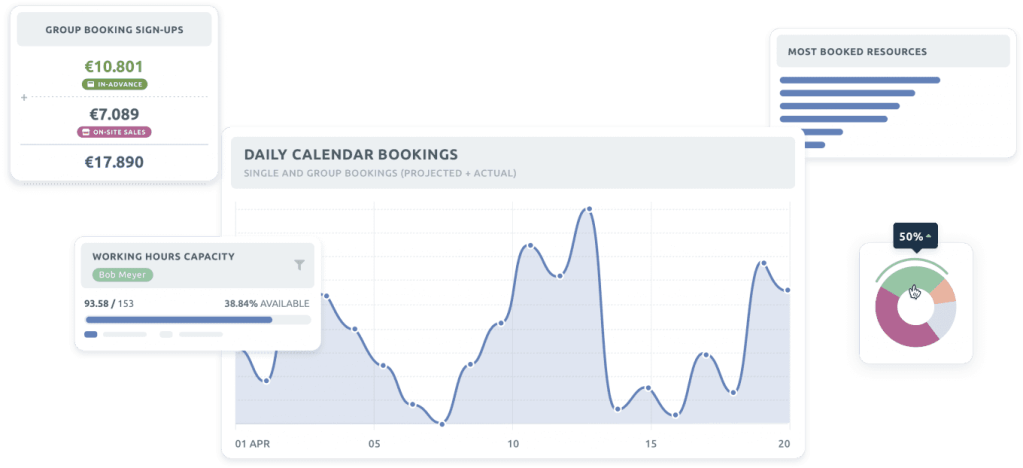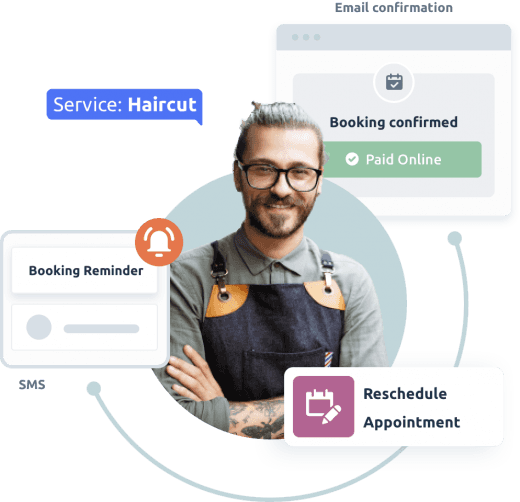

Axelle Dervaux
Axelle Dervaux has experience in digital marketing with a focus on B2B marketing for SaaS companies.
It's no secret that online appointment self-scheduling solutions, like TIMIFY, have revolutionized the customer experience, adding tremendous efficiencies that were impossible through traditional booking methods, such as phone calls or email.
But it gets better! While finding an open time that works for both you and your client is no longer a hassle, online appointment scheduling tools have introduced an even more powerful efficiency booster — appointment analytics.
In this article, we’ll look at five ways you can leverage appointment data to optimize your customer experience, streamline operations and minimize your customer support costs.
__________________________
What Are the Challenges Associated With Appointment Booking?
Appointment self-scheduling has made it faster and easier to manage a service calendar in real time while preventing accidental double-bookings and reducing rescheduling, cancellations, and other inconveniences.
However, just like in the old offline days, online tools can’t completely prevent services or employees from being booked too fast resulting in extended periods of time without available slots, leading to frustrated customers and overstretched staff.
At the other end of the spectrum, traditional appointment booking tools that don't offer strong resource scheduling capabilities can’t completely avoid overstaffing during slow periods, leading to higher costs.
Finally, there’s the pesky problem of no-shows, which not only waste your time but also prevent you from being able to book other appointments during those time slots leading to lost revenue and decreased productivity.
All of the above can be easily solved with appointment analytics. By taking a data-driven approach, you can begin to refine your appointment scheduling process to minimize or prevent the above common issues, improving your customer experience and reducing operating costs.
__________________________
What Is Data-Driven Appointment Scheduling?

Source: timify.com
Data-driven appointment scheduling is the process of using historical booking data to optimize the overall online appointment process.
By analyzing this data, you can discover appointment patterns and trends that can help you develop more efficient schedules, taking into account the natural peaks and troughs of your business cycle.
You can then use these efficiencies to optimize staffing levels and streamline your operating costs while increasing customer satisfaction.
You can also use these patterns and trends to anticipate and reduce the number of no-shows, increasing the efficiency of your appointment booking process.
__________________________
5 Tips for Refining Appointment Booking Using Data
Here are five tips that you can use to optimize your online appointment scheduling process with the help of booking data analytics:
1. Use Data to Optimize Gaps In Your Scheduling
Your booking frequency can be affected by a multiplicity of factors. From time-of-day fluctuations to weather issues, you’re going to find that it’s hard to keep your appointment calendar occupancy evenly booked.
By using scheduling data patterns to predict your ebbs and flows, you can either offer discounts or other incentives during extended blocks of empty time slots or use this information to reduce your staffing requirements during slow times.
Conversely, you can use these patterns to predict when periods of high demand are likely to occur to increase appointment availability and plan for increased staffing levels.
2. Optimize Appointment Reminders

Source: timify.com
While appointment reminders are critical for ensuring that your appointment booking process runs smoothly, the time and method of delivery can dramatically impact their effectiveness.
By using historical data, you can determine what times of the day and days of the week increase open rates.
You can also use data to determine what method of delivery is the most effective for a specific type of clientele or a type of service.
For example, you may find out that automated voice messages, emails, and SMS messages don’t work the same across different demographics.
By optimizing appointment reminder messages, you’ll increase your show rates and improve customer satisfaction.
3. Use Data to Identify No-Show Patterns
Appointment no-shows are inevitable, but by using data to identify patterns, you can take steps to reduce your no-show frequency.
For example, if you notice that a particular type of appointment is more likely to be missed than others, you can send reminders using multiple channels to add “social pressure” to attend (e.g. SMS plus email or phone plus email, depending on the demographic.).
You can also message customers to remind them what your cancellation policy is before the deadline so they’ll be less likely to miss their appointment if they know that there will be financial consequences.
4. Use Data to Improve Your Customer Service
Appointment booking data can be used to improve your overall customer service. For example, you can optimize staffing levels and service delivery across your organization by analyzing your average wait times.
You can also use booking data to optimize the frequency of appointment reminders that leads to the best attendance outcomes. For example, some services or types of clientele may only require a single reminder, while others may require multiple reminders to drive up attendance.
Last but not least, you can use previous appointment data to pre-populate parts of booking forms for returning customers, saving them time and effort and improving your overall customer experience.
5. Use Data to Troubleshoot Appointment Booking Issues
Finally, if you're having trouble with your appointment booking process, data can be a valuable asset for troubleshooting.
By looking at your historical appointment data, you can identify service bottlenecks and areas for improvement.
For example, by tracking service times across your organization, you could easily spot areas of revenue opportunities and take the appropriate actions to optimize your top line.
Then, you could increase bookings for services with short delivery times and increase prices for services with longer delivery times.
__________________________
Summary of Benefits

Source: timify.com
Data-driven appointment booking can boost the efficiency of your appointment booking process, increasing revenue, reducing costs, and improving customer satisfaction. Here’s a summary of your key benefits:
Appointment scheduling data can be used to:
- Identify no-show patterns and take steps to reduce their frequency
- Identify open appointment times to optimize staffing levels
- Improve customer satisfaction by identifying problem areas
- Troubleshoot appointment booking issues to improve operating efficiency
- Optimize your resources and free up time for your team members
- Make more informed business decisions
- Find new opportunities for revenue growth
- Provide valuable insight into how customers interact with your services
__________________________
Some Advice on How to Get Started With Data-Driven Appointment Booking
If you're looking to get started with data-driven appointment booking, here are a few tips:
1. Collect appointment data: Appointment data can be collected in several ways, including through appointment booking software, customer surveys, and appointment cancellation logs.
2. Analyze it: Once you've collected appointment data, it's time to analyze it. Look for patterns and trends in the data, and identify areas for improvement.
3. Implement changes: Based on your analysis, implement changes to your appointment booking process. These changes could include changing the frequency of automated reminders, offering discounts for certain types of appointments, or changing the way you schedule appointments altogether.
4. Monitor results: Finally, monitor the results of your changes to see if they have the desired effect. If not, make adjustments as needed.
By following these tips and taking a data-driven approach to appointment scheduling, you’ll be able to improve the efficiency of your appointment booking process, leading to cost savings and improved customer satisfaction.

About the author
Axelle Dervaux
Axelle Dervaux has experience in digital marketing with a focus on B2B marketing for SaaS companies. She’s working in various marketing fields such as SEO and SEA, social media, lead nurturing, customer retention, product marketing. She is the Marketing Manager at clicdata.com, a cloud-based business intelligence, and data management platform. You can connect with her on LinkedIn.
Related articles


